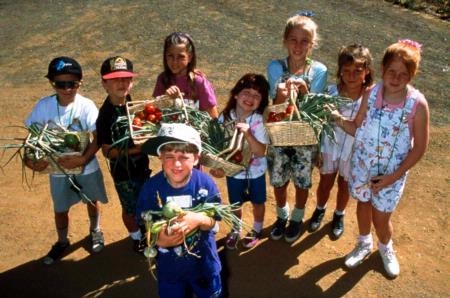
Posts Tagged: school gardens
4-H Spring Farm Field Trips

Specially trained and dedicated volunteers work alongside staff to deliver fun and hands-on agricultural based lessons. For many Kindergarteners, this is their first time on a farm. Getting a glimpse of where food comes from, planting seeds and learning what makes them grow are unforgettable experiences. Older students delve deeper into plant growth and development, discover the important role pollinators play in our food system, and learn about the agricultural county where we live.
Picking and sampling farm fresh vegetables such as beets, carrots, sugar snap peas, and lettuce are favorite activities with all ages and a great way to introduce MyPlate, the newest USDA guide to healthy eating choices, and encourage daily physical activity. What can be better than getting your hands dirty, smelling the rich Santa Paula soil, and eating vegetables you helped harvest? Children aren’t the only visitors. Over 300 parents and teachers will visit, learn, and munch alongside youth.
The cost of buses makes a trip to the farm prohibitive for many schools. When visiting the farm is not an option, lessons delivered in the classroom bring the farm to life. The 4-H Classroom Outreach Program is an opportunity to learn about agriculture without leaving the school grounds.
Yes, it’s a busy and exciting time. Happy spring!
Backyard conservation
The Natural Resource Conservation Service (NRCS) works extensively with the nation’s farmers and ranchers to protect soil, water, air, plant, and animal resources while meeting production goals.
Working with agricultural producers allows NRCS to promote conservation practices approximately 1.4 billion acres of the privately held land in the United States. About 92 million acres of land in our country is tended by home gardeners. In an effort to promote conservation on these lands, NRCS has partnered with other organizations to produce, Backyard Conservation: Bringing Conservation From the Countryside to Your Backyard.
This full-color and informative online resource highlights 10 conservation activities that can be used in your backyard, shared spaces, and public places too.
Topics include:
- Trees add beauty and so much more.
- Trees, shrubs, and other plants can provide homes and food for wildlife.
- A backyard pond will likely become the focal point for all your backyard conservation.
- Wetlands filter excess nutrients, chemicals, and sediment and provide habitat for a host of interesting creatures.
- Composting turns household wastes into valuable fertilizer.
- Mulching cools, protects, and enriches the soil.
- Apply only those nutrients the plants can use. (See our previous post on soil test kits to help you get accurate test results.)
- Terracing makes flower and vegetable gardening possible on steep slopes.
- Drip irrigation and other water conservation practices can save water and money.
- Early detection and treatment of pests means a healthier growing environment.

Backyard Conservation from NRCS can help people create beautiful and healthy environments! Photo from NRCS resource.
A Garden of Words
Designed for elementary and after-school gardening programs, UC ANR’s A Garden of Words/Un jardin de palabras: A Bilingual Gardening Dictionary will help verbal communication in any bilingual garden.
The author of this publication is Susan Spector, a Master Gardener volunteer from Santa Barbara County. The vocabulary is quite extensive and includes the following word categories
- Tools
- Measurements
- Gardening vocabulary
- Gardening phrases
- Plants
- Vegetables
- Herbs
- Fruits
- Garden helpers
- Garden pests
This resource can be accessed by clicking here.

Youth with vegetables harvested from school garden.
Photo by Suzanne Paisley.
Fresh Fruits and Vegetables: A Centerpiece for a Healthy School Environment
Fresh fruits and vegetables have been shown to improve children’s ability to learn while reducing the likelihood of obesity. When children are provided fresh, quality produce most of them prefer the produce over other foods.
In an effort to increase children’s intake of fresh produce a free, two-day training designed for school personnel and community partners will be traveling in our state this fall. The training will provide tools to support an increase of fresh fruits and vegetables on school campuses.
The training will be held in Ventura on November 9 and 10. While the training is free, registration is required. For further details, other dates or to register, please click here.
UC Davis Department of Nutrition
At this time of year, many of us consume different foods than we normally do. As the year winds down, we begin to think of what we will do differently when we put up next year’s calendar.
The UC Davis Department of Nutrition is a great place to find science-based nutrition information. In addition to conducting research, they train new nutrition educators, and extend nutrition programs. You can read more about their mission here.
On the department’s nutrition information page, many links to great articles and publications can be found.
Highlighted subjects include:
- School gardens help teach nutrition and promote good eating habits
- Nutrition Info Sheets covering a variety of nutrition information
- Nutrition Perspectives, a publication providing researched-based information on ongoing nutrition subjects
- Maternal and Infant Nutrition Briefs
- Curriculum designed to help children form better food choices. The targeted ages vary depending on the curriculum.
Other great, science based nutrition information can be found using the Nutrition, Family and Consumer Science button on our homepage.
I will be out of the office the rest of this week and will post a new article when I return Monday.
